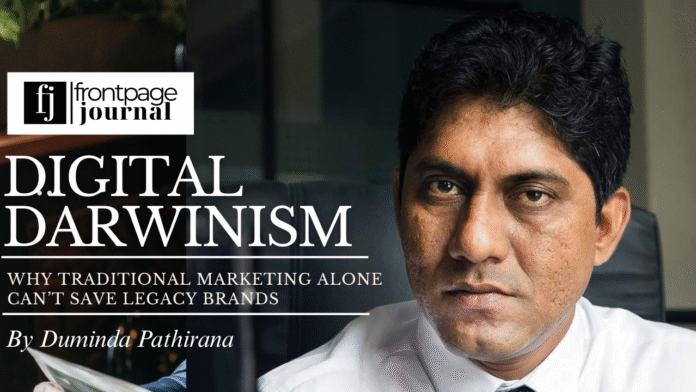Why Traditional Marketing Alone Can’t Save Legacy Brands
In an age defined by exponential digital growth, legacy brands are confronting an unforgiving reality. No matter how long a brand has been in the game, customer loyalty is no longer guaranteed, and brand heritage offers little protection in a digital-first economy. This phenomenon, often referred to as “Digital Darwinism,” explains why businesses that fail to adapt to digital transformation are being swiftly outpaced, even eclipsed, by more agile and digitally native competitors. For C-suite executives shaping strategy in this new environment, the message is clear, evolve or risk irrelevance.
What separates digital Darwinism from previous cycles of disruption is the pace and unpredictability of consumer behavior. Today’s buyer is curious, demanding, and impatient; armed with smartphones, search engines, and social media, they operate in micro-moments where decisions are made in seconds. More than 80 percent of B2B and B2C buying journeys begin online, often before the customer ever interacts with a brand representative. And with digital touchpoints expanding across devices and platforms, control over the brand narrative has shifted from the company to the consumer.
This shift renders traditional marketing strategies; print ads, billboards, static promotions, increasingly obsolete as standalone approaches. While these methods can still play a supporting role, relying on them exclusively ignores the core truth of modern marketing; consumers demand personalized, context-aware, two-way engagement. Static campaigns cannot offer the agility required to respond to this environment. Executives must recognize that marketing today is not a department. It is a business model function driven by data, content, analytics, and customer experience.
Adapting to digital Darwinism starts with mindset. It requires board-level recognition that transformation is not a technical fix but a strategic imperative. The organizations thriving in this landscape are those that treat digital not as a tool, but as an operating principle. Brands like Netflix, Amazon, and even traditionally analog players like Nike have reengineered their models around data, rapid iteration, and omnichannel personalization. These companies are not just marketing better, they are learning faster, responding quicker, and building smarter customer ecosystems.
Key to this evolution is the strategic integration of the digital marketing mix, also known as the 7Ds: Digital Product, Digital Price, Digital Place, Digital Promotion, Digital People, Digital Process, and Digital Physical Evidence. Unlike the traditional 7Ps, this digital-first framework accounts for real-time data usage, consumer interface design, and AI-driven personalization. For instance, while “Place” once referred to store location or distribution, digital “Place” now means app design, website UX, and mobile responsiveness, all crucial to conversion in an attention-scarce world.
Digital personalization, powered by AI and behavioral analytics, is one of the defining advantages of the new era. Companies that invest in customer data platforms (CDPs) and integrate analytics into every touchpoint are building granular, predictive profiles of their audience. These insights allow for hyper-relevant messaging, content delivery, and product offers, enhancing ROI while reducing marketing waste. Research shows that 40 percent of consumers purchase more from brands offering personalized experiences. More importantly, personalization builds the kind of trust and intimacy that traditional advertising simply cannot replicate.
However, embracing digital marketing at scale also means navigating a more complex regulatory and ethical landscape. GDPR (General Data Protection Regulation), evolving data privacy norms, and rising consumer awareness have made transparency and compliance non-negotiable. Smart organizations are embedding privacy-by-design principles into their strategies, ensuring that data is not just gathered, but handled with respect, consent, and purpose.
It is also worth emphasizing that digital transformation does not mean abandoning traditional strengths. In fact, multichannel marketing, blending digital and traditional channels offers a more holistic approach. But success lies in orchestration. A consistent message, adaptive across formats, responsive in real time, and measurable in outcomes, is what today’s customer expects. Brands that silo their efforts between digital and offline divisions are already at a disadvantage.
For executives facing pressure to defend margins, accelerate growth, and maintain brand equity, the lesson is stark, traditional marketing alone will not drive sustainable results. What’s needed is a strategic redesign that aligns marketing with the modern buyer’s journey; grounded in data, enriched by content, and continuously optimized through feedback loops.
Digital Darwinism is not a threat.It is a filter. It distinguishes the brands willing to evolve from those that will fade. For leaders who choose to adapt, the payoff is more than survival. It is the opportunity to redefine relevance, reconnect with customers, and reclaim leadership in markets where digital fluency is now the most important competitive edge.
In this moment, strategy must shift from preservation to adaptation. The next generation of market leaders will be those who understand that marketing is no longer about messaging. It is about matching the speed of change and outpacing it.




